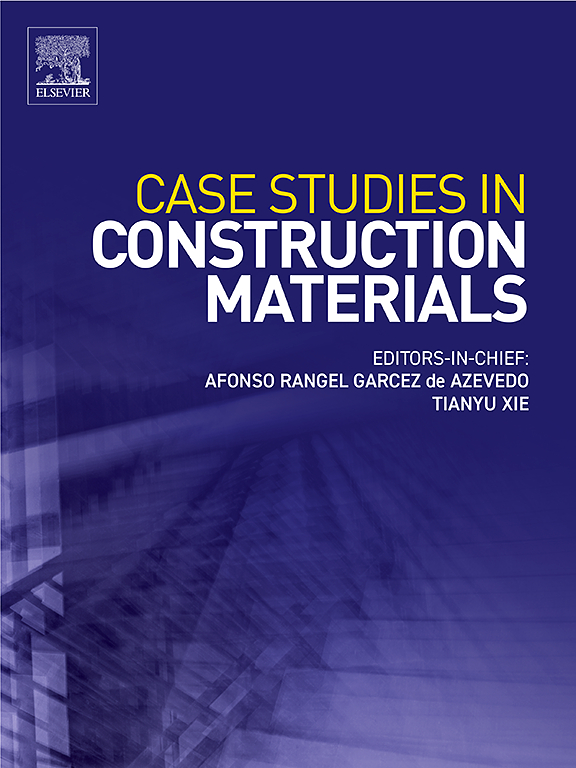Creep and mechanical behavior after sustained loading of red mud-slag based geopolymer concrete at early-age
IF 6.6
2区 工程技术
Q1 CONSTRUCTION & BUILDING TECHNOLOGY
引用次数: 0
Abstract
To investigate the effects of stress levels, silica fume contents, fiber types, and fiber contents on the drying shrinkage, creep, and mechanical properties of early-age Red mud-Slag based GeoPolymer Concrete (RS-GPC), a comprehensive series of experiments, including compressive strength, drying shrinkage, creep were conducted. Based on experimental results and existing models, drying shrinkage and creep prediction models, as well as constitutive relationship models before and after creep, were developed. Respectively, the results revealed that the 7-day cube compressive strength, 28-day drying shrinkage, and creep coefficient of RS-GPC ranged from 29.36 to 57.03 MPa, 330–500 με, and 1.71–2.03. The incorporation of silica fume significantly reduced drying shrinkage but notably weakened compressive strength and creep. Conversely, optimal content of steel fiber and basalt fiber enhanced these properties significantly. After creep, the elastic modulus of RS-GPC increased, whereas peak and ultimate strain decreased. For most test groups, axial compressive strength after creep decreased, with the exception of those incorporating silica fume. The proposed stress-strain curve equations demonstrated good agreement with experiment, underscoring the impact of sustained loading on constitutive relationships. In conclusion, silica fume and fibers exhibit dual effects on the mechanical and shrinkage properties of RS-GPC. Moreover, creep significantly reduces axial compressive strength. It is necessary to consider mechanical properties after creep in the structural design of RS-GPC members subjected to sustained loading.
赤泥-矿渣基地聚合物混凝土早期持续加载后的徐变与力学行为
为了研究应力水平、硅灰含量、纤维类型和纤维含量对早期红泥渣基地聚合物混凝土(RS-GPC)干燥收缩、徐变和力学性能的影响,进行了一系列综合试验,包括抗压强度、干燥收缩、徐变。基于实验结果和已有模型,建立了干燥收缩和蠕变预测模型以及蠕变前后的本构关系模型。结果表明,RS-GPC的7 d立方体抗压强度、28 d干燥收缩率和蠕变系数分别为29.36 ~ 57.03 MPa、330 ~ 500 με和1.71 ~ 2.03。硅灰的掺入显著降低了干燥收缩率,但显著削弱了抗压强度和蠕变。相反,优化钢纤维和玄武岩纤维的掺量可显著提高这些性能。蠕变后,RS-GPC的弹性模量增大,峰值应变和极限应变减小。对于大多数测试组,轴向抗压强度在蠕变后下降,除了那些加入硅灰。本文提出的应力-应变曲线方程与试验结果吻合较好,说明持续加载对本构关系的影响。综上所述,硅灰和纤维对RS-GPC的力学性能和收缩性能具有双重影响。此外,蠕变显著降低轴向抗压强度。在持续荷载作用下,RS-GPC构件的结构设计中需要考虑蠕变后的力学性能。
本文章由计算机程序翻译,如有差异,请以英文原文为准。
求助全文
约1分钟内获得全文
求助全文
来源期刊

Case Studies in Construction Materials
Multiple-
CiteScore
7.60
自引率
19.40%
发文量
842
审稿时长
63 days
期刊介绍:
Case Studies in Construction Materials provides a forum for the rapid publication of short, structured Case Studies on construction materials. In addition, the journal also publishes related Short Communications, Full length research article and Comprehensive review papers (by invitation).
The journal will provide an essential compendium of case studies for practicing engineers, designers, researchers and other practitioners who are interested in all aspects construction materials. The journal will publish new and novel case studies, but will also provide a forum for the publication of high quality descriptions of classic construction material problems and solutions.
 求助内容:
求助内容: 应助结果提醒方式:
应助结果提醒方式:


